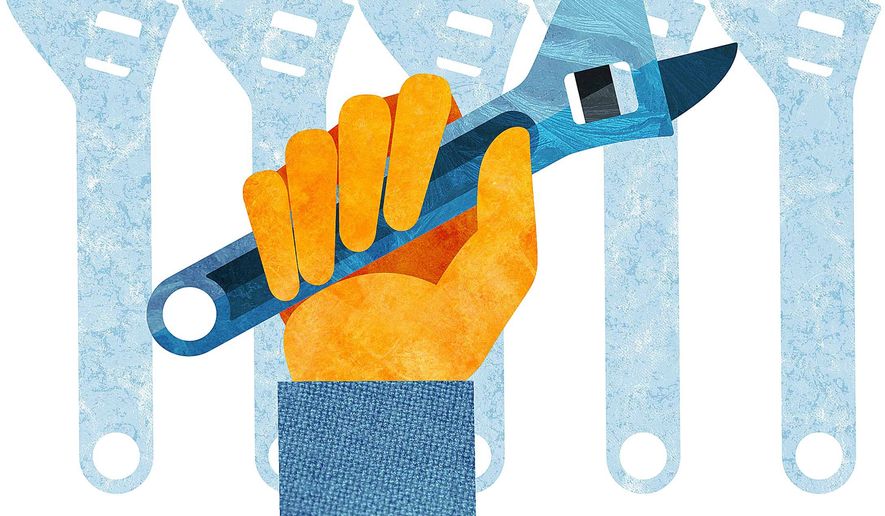OPINION:
The following analysis is part of The Washington Times Voter Guide, which outlines the candidates’ policies on critical issues.
Former President Donald Trump promises a “manufacturing renaissance” if reelected. Vice President Kamala Harris wants to do the same, vowing to “invest in and continue to rebuild America’s industrial capacity” if she wins in November. Each has a plan to achieve this working-class comeback.
Mr. Trump says he will bring millions of jobs back to the United States through tariffs, tax cuts and deregulation. When he was in the White House, Mr. Trump imposed tariffs on steel, aluminum, washing machines, solar panels and goods from China. This affected over $380 billion in trade.
As GOP nominee, he proposes tariffs of between 60% and 100% on Chinese goods. For goods imported from elsewhere, tariffs would be as high as 20% to level the playing field with allies and adversaries that impose tolls on our goods.
“Perhaps the most important element of my plan to make America extraordinarily wealthy again is reciprocity,” Mr. Trump said, outlining his economic plan Thursday in Detroit.
“China will charge us a 200% tariff. Brazil is a big charger. The biggest charger of all is India,” he added.
Mr. Trump invites the companies and nations that want to avoid tariffs to move their factories to the U.S. The Tax Foundation estimates the proposed tariffs would generate up to $2.5 trillion over 10 years, which could fund priorities such as the military, Medicare and Social Security.
Ms. Harris calls Mr. Trump’s tariff plan “a national sales tax” that will raise prices for consumers. But Mr. Trump’s record paints a different picture.
With tariffs in place, Mr. Trump left office in January 2021 with inflation at 1.4%. Inflation peaked at 9% during President Biden’s years in the Oval Office. The cost of goods rose, on average, 20% while inflation-adjusted average weekly earnings dropped from $397 during Mr. Trump’s time to $384 now. That’s a 3.3% pay cut.
Mr. Trump also used tariffs as a diplomatic bargaining chip. Tariffs persuade leaders in Mexico to implement the “Remain in Mexico” policy that reduced illegal immigration. Mexico also agreed to send 6,000 of its troops to its border with Guatemala.
While the administration has kept Mr. Trump’s China tariffs, it’s unclear if Ms. Harris will extend them. Her campaign has not addressed the question.
On her website, Ms. Harris says she will “support American leadership in semiconductors, clean energy, AI, and other cutting-edge industries of the future” while addressing “unfair trade practices from China or any competitor that undermines American workers.”
Indeed, Ms. Harris wants to distribute $100 billion in federal subsidies to specific industries to revitalize the economy. She plans to fund this proposal by allowing the Republican tax overhaul of 2017 to lapse for those earning more than $400,000 yearly, by raising corporate taxes to 28% from 21% and by imposing a tax on unrealized capital gains.
The Democratic candidate has built her plan around the Keynesian theory that government intervention stabilizes an economy. Under the Biden-Harris administration, Congress passed the Inflation Reduction Act, which distributed tens of billions to clean energy projects, and the CHIPS Act, which provided $39 billion to fund manufacturing plants in the United States and $11 billion for semiconductor research and development. The Infrastructure Investment and Jobs Act invested $1.2 trillion.
These programs, Ms. Harris says, have created 730,000 manufacturing jobs. Most of those jobs reflect the recovery from the COVID-19 pandemic. According to Bloomberg: “In the 16 months since October 2022, the US economy actually has only added 34,000 manufacturing jobs. In the month of February, factory payrolls actually dropped — by 5,000.
“In three key industrial swing states (Michigan, Pennsylvania, and Wisconsin) a collective 39,000 fewer people are working in manufacturing than five years ago.”
The Biden-Harris administration says $910 billion in private manufacturing investment under it will create hundreds of thousands of new jobs over the next decade. Those gains have been slow to materialize.
For instance, the $7.5 billion federal investment in electric vehicle charging station construction has thus far produced only seven stations in two years — far short of the 500,000 promised by 2030. A $45 billion rural broadband initiative has been plagued with delays and bureaucracy.
Halfway through the five-year Infrastructure Investment and Jobs Act, only 38% of the funding has been announced, let alone spent.
Voters will decide which of the two has the better approach to achieving the working-class comeback.





Please read our comment policy before commenting.